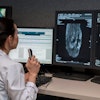Screening tests that are sold directly to consumers by commercial firms without physician referrals inflate healthcare costs and erode efforts to provide high-value care -- and medical imaging is a big part of the problem, according to a pair of opinion articles published on August 27 in the Annals of Internal Medicine.
The increasing availability of direct-to-consumer screening tests is undermining doctors' efforts to provide high-quality care, wrote co-authors Drs. Erik Wallace, John Schumann, and Steven Weinberger. Wallace and Schumann are from the University of Oklahoma School of Community Medicine; Weinberger is executive vice president of the American College of Physicians (ACP).
"We think commercial companies that are pushing screening tests are doing so inappropriately because they're not informing consumers about either the indications for such tests or the potential harms and risks that could come from them," Weinberger told AuntMinnie.com.
Companies that sell packages of screening tests that are performed without the benefit of the traditional patient-physician relationship are proliferating; tests are offered at churches, pharmacies, fitness centers, and shopping malls, Wallace and colleagues wrote (Ann Int Med, August 27, 2012).
"Commercial companies may offer various screening tests, some with proven benefit, such as measurement of blood pressure and blood sugar and lipid levels," the team wrote. "However, we are particularly concerned about the misapplication of technology, such as the use of ultrasonography [for the carotid arteries to assess for plaques and stenosis, of the heel to assess for osteoporosis, and echocardiography] in the direct-to-consumer screening market as a driver of expensive and unnecessary care."
When these screenings are offered in a church and sponsored by a trusted public organization, consumers may have a skewed understanding of the quality and appropriateness of services provided, the team wrote. Although companies offering these screening services may tell their clients that they should share any "abnormal" test results with their physicians, specific risks and costs of further testing and treatment are generally not explained, according to Wallace and colleagues.
"Because of a lack of counseling by these companies about the potential risks of an 'abnormal' test result, the consumer is initially unaware that [the screening] may open a Pandora's box of referrals and additional testing to monitor or treat these abnormal findings," the team wrote. "Our medical system and society bear the cost of poor coordination of care and additional testing and treatment to follow up on unnecessary 'abnormal' screening test results."
Although commercial screening services would seem to support a patient's autonomy, the failure to fully disclose the appropriate indications and consequences of testing is deceptive, because patients purchase these services with a false hope of benefit, Wallace and colleagues wrote. If screening asymptomatic people in the general population with tests that are not medically indicated is neither beneficial nor enhances behavior change, how can it be ethical to allow marketing of such tests to the public?
"We feel there's a professional obligation, a medical ethics obligation, to be doing procedures that are right for patients -- not going out there and pushing things that don't have a clear indication," Weinberger told AuntMinnie.com.
Reducing imaging overuse
In a related opinion also published online August 27, lead author Dr. Vijay Rao and colleague Dr. David C. Levin, both from Thomas Jefferson University, describe why eliminating inappropriate imaging studies and other tests and treatments can only improve the practice of healthcare -- reducing cost and also radiation risk to patients.
In January, the Annals published a list from ACP that identifies 37 medical tests -- of which 18 are imaging tests -- that the organization believes are overused in medical practice (January 17, 2012, Vol. 156:2, pp. 147-149). In their August 27 opinion, Rao and Levin pointed out that imaging studies are also a large proportion of the tests listed by the Choosing Wisely campaign, an initiative by the American Board of Internal Medicine Foundation (ABIMF) that identifies commonly overused tests and treatments.
"As radiologists, we were interested to note that 24 of the 45 [on the Choosing Wisely list] were directly related to diagnostic imaging," Rao and Levin wrote.
Imaging is overused because of the proliferation of advanced imaging equipment installed in nonradiologist physician offices, because physicians worry about malpractice liability, and because radiologists are not proactive in their interactions with referring physicians to reduce inappropriate or unnecessary imaging tests, according to Rao and Levin.
"Ask almost anyone in radiology and they'll say that every day they see requests for imaging studies that aren't necessary given the clinical reality of the patient -- but the tests are being ordered for defensive purposes," Levin told AuntMinnie.com. "Defensive medicine is a huge [contributor to imaging overuse]."
Radiologists can help educate ordering physicians who lack informed knowledge of which imaging tests, if any, are most appropriate for the patient's clinical circumstances. They also need to acknowledge their own potential conflicts of interest about overuse of imaging studies, Rao and Levin wrote.
"The more imaging studies [radiologists] do, the more they earn," they wrote. "Radiologists should recommend additional imaging tests in their reports only when such additional testing is truly warranted. Too often, such casual recommendations about additional testing tie the hands of treating physicians and compel them to order further tests largely for defensive purposes."
How can the problem of imaging overuse be resolved? Radiologists need to modify their daily routines, recommend testing only when it's indicated, and intervene to cancel inappropriate tests when they are ordered. Physicians should also be aware of the American College of Radiology's (ACR) evidence-based appropriateness criteria for imaging that were first developed in the 1990s, Rao and Levin concluded.
"If imaging were better controlled, the downward pressure on reimbursements would be reduced," Levin told AuntMinnie.com. "It's in everybody's interest, including radiologists, to try to get rid of inappropriate imaging use."




















